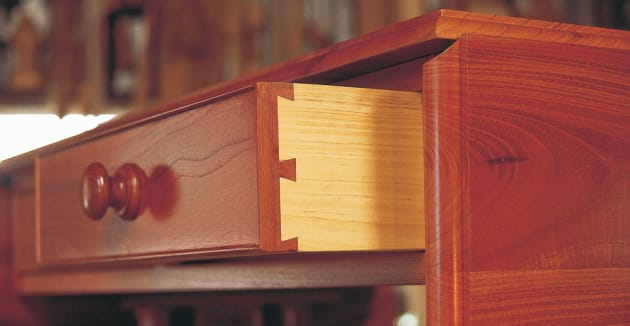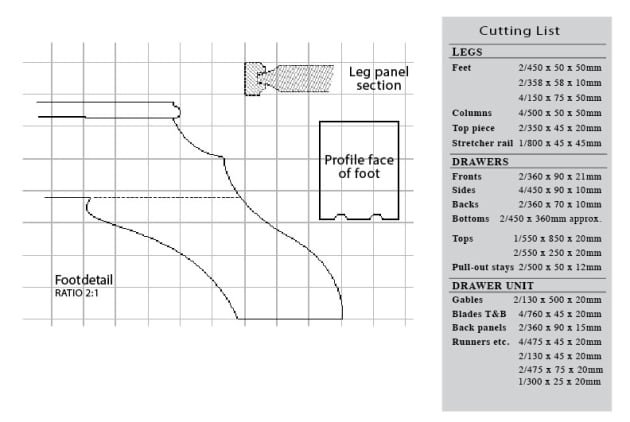Making a Cedar Sofa Table
Words: Frank Wiesner
Photos: David Seeto
Some time ago one of my customers asked me to mill a cedar tree that was dying behind a house on a large suburban block. The main trunk was short and almost of no use other than for turning blanks, but there were some rather good branches that I managed to cut into 25mm boards and stacked out to season. The colour was not too bad but the grain a little wild as can be expected from branches.
About 18 months later the people contacted me about making some furniture from this wood. Since they have two sons they asked me to make three sofa tables: one for each of the sons and one for mum and dad. It’s a little like the farmer who was breeding chooks with six legs because his wife, himself and his four sons all liked to eat drumsticks!
The wood was well dry by this time. Where I live, in sub-tropical south-east Queensland, 25mm cedar boards will dry in nine months. As I was only able to get the 25mm boards out of the branches the 50mm cedar I needed for the tables came from my own stocks.
I started by sorting out the cedar for the tops and the drop-leaves. Since the branches were a little bowed, and I also had to dock them, I did not have many long boards to play with. The longest was 1400mm, so I ran the grain of the table tops across their length. This also worked out better for hinging the drop-leaves on both ends where the traditional rule joint is used.
Once happy with grain I glued the tops up and put them aside to dry. By doing the things first that you use last the joints have time to settle down.
I used urea glue for the tops as I find white glue gums up the belts on my panel sander. For all the other joinery on the tables I used Syntec AV275.
Rule Joint

For the sections where the leaves fold I cut a rule joint on a spindle moulder, using matching round-over and cove bits. Matching router bits could also be used, however the spindle moulder gives a much cleaner finish that doesn’t fluff or fur up. Test cuts are made on scrap timber before cutting the two profiles on the top and leaves. The offset hinges required are sold as ‘rule joint hinges’ by speciality hardware suppliers. They can either be let into the top and leaves or simply screwed on.

Showing the end view of the table base.
If you use the rule joint on the two leaves there is a little trap to watch out for. As the drop-leaf swings down it folds inwards by the amount of radius on the joint itself (usually 10–13mm). So the knob or finger pull of the slide-out support that holds up the leaf has to fit beneath the overhang of the top, less the joint radius. If you overhang the top by 25mm each end, when you fold the leaf down you will be left with only a 12mm space to access the pull-out support.

The support for the drop-leaves slides into the carcase.
Drawer Unit

Above: The carcase for the top and components for the base await assembly.
The two sides are 130mm long, 500mm wide and 20mm thick. I ran the grain vertically so endgrain wouldn’t be seen at the front. They are held together with two skeleton frames made out of 45 x 20mm stock. These frames are mortised together but the outside runners and kickers are glued only at the front and are a firm fit into the back blades. To allow for expansion and contraction of the gables you can have a 3–4mm gap at the shoulders.
The 75 x 20mm centre pieces are fully glued. The vertical mullions (45 x 20mm) are mortised through the top and bottom blades and the four blades are dovetailed into the sides.
After assembly, a 25 x 20mm guide is glued between the mullions. When you assemble the unit you should slot screw one or two screws through the runners and kickers into the gables to hold them straight.
Next are the two 15mm thick back panels. I fielded them and left about 7mm flat on the end of each field. After beading the inside and locating the panel, I mitred an 8 x 5mm bullnosed bead around the outside.
Making the Drawers
The cedar drawer fronts and hoop pine drawer sides were dovetailed together.
I used a 21mm drawer front and 10mm thick hoop pine sides and back. This saves wood as you can cut a 25mm board in half for the sides. This will look much less bulky on such a small drawer. To stop these narrow drawer sides from cutting into the runners I fitted slips to double their running surface.
A cocked bead around the drawer fronts finished them off, and at the request of the customer I supplied traditional wooden screw-on knobs. Stops were fitted at the back of the drawers.
Timber buttons are used to attach the top to the drawer unit.
Leg Frames
Each leg frame consists of a foot, two columns with a panel in between and a 21 x 45mm top piece. Each foot is made from four pieces of cedar, including two glued-on bottom wings and a 10mm capping piece. The columns have a 40mm long dowel turned at the bottom and a 20mm long dowel turned at the top.
I didn’t want the leg system to look too busy with fancy turning so I went for straight turning with the addition of a few 5mm beads. To get a good line on the straight part of the turning and nicely rounded beads is not as easy as it might look—I found the tapered stretcher much easier to turn. I also think it would not look out of place if you used two stretcher rails.
The panel is 15mm cedar, fielded on both sides with a mitred and moulded frame that is nailed at the top and bottom only, to hide the nails. I decided not to fit the panels at this stage as it would be easier to screw them in place (top and bottom) after polishing.
Finish
I don’t like staining my jobs, but if I have to I will. The cedar was a little pale but started to brown a little as I was working with it, and in time I think it will tone down nicely. After fine sanding I gave the tables two coats of sanding sealer and three coats of nitrocellulose lacquer.
It is very satisfying to use timber you have milled and dried yourself. This job also has all the good solid and traditional ways of making furniture. You could change things around a little but I wouldn’t cheapen it just to save a little time.
Diagrams and a cutting list for the tables are shown below.
First published in Australian Wood Review issue 43.
Frank Wiesner designs and makes furniture in Toowoomba, Qld.










